Art education serves a myriad of purposes that extend beyond the mere acquisition of skills in drawing, painting, or playing an instrument. It is a holistic approach to learning that enriches students' lives in numerous ways. In this comprehensive response, we will delve into the multifaceted benefits of art education, supported by research and real-life examples.
| Benefit | Description | Research/Examples |
| Cognitive Development | Art education stimulates brain development and enhances cognitive abilities. Engaging in artistic activities improves problem-solving skills, Critical Thinking, and creativity. For instance, learning music has been shown to enhance mathematical abilities due to the pattern recognition involved in both disciplines (Hetland & Winner, 2004). | A study conducted by the National Endowment for the Arts found that students who participated in arts education programs scored higher on standardized tests in reading, math, and science compared to their peers who did not receive such instruction (Catterall, 2009). |
| Emotional Intelligence | Art provides an outlet for self-expression and emotional release. It helps individuals understand and manage their emotions better, fostering empathy and emotional intelligence. Through creating art, students can explore complex feelings and develop resilience. | The American Psychological Association emphasizes the role of art therapy in promoting emotional well-being and mental health recovery (Malchiodi, 2013). Many schools have integrated art programs as part of their social-emotional learning curricula to support students' emotional development. |
| Cultural Awareness | Exposure to diverse art forms from different cultures broadens perspectives and promotes cultural understanding. Art education encourages appreciation for global heritage and fosters inclusivity. | UNESCO highlights the importance of arts education in achieving cultural diversity and promoting intercultural dialogue (UNESCO, n.d.). For example, studying world art history allows students to explore various artistic traditions, such as African masks, Chinese calligraphy, or European Renaissance paintings, fostering cross-cultural respect. |
| Career Opportunities | A background in art education opens doors to a wide range of career paths, including visual arts, design, advertising, architecture, and more. It cultivates skills that are highly valued in the job market, such as attention to detail, creativity, and collaboration. | According to a report by the President's Committee on the Arts and the Humanities, individuals with arts education backgrounds have higher employment rates and earn higher incomes than those without such training (President's Committee, 2017). Many successful professionals, like Apple co-founder Steve Jobs, attribute their innovative thinking to their exposure to art and design education. |
| Social Skills | Collaborative art projects teach teamwork, communication, and compromise. Working together on artistic endeavors encourages students to listen actively, give and receive feedback constructively, and appreciate diverse viewpoints. | In classrooms where group art projects are common, teachers often observe improved social dynamics among students. These experiences mirror real-world work environments where collaboration is key, preparing students for future professional settings (Dewey, 1934). |

Art education is not just about nurturing future artists; it is about equipping all learners with essential life skills and fostering well-rounded individuals. By integrating arts into the curriculum, educators can create a more engaging, inclusive, and effective learning environment that prepares students for success in all aspects of life.
FAQs:
Q1: At what age should children start receiving art education?
A: Children can benefit from art education at very young ages. Even simple activities like finger painting or playing with clay can introduce toddlers to creative expression. As they grow older, structured art classes can further develop their skills and understanding.
Q2: How can parents support their children's art education at home?
A: Parents can encourage art education at home by providing materials for creative exploration, such as paints, crayons, and craft supplies. They can also visit museums, galleries, and attend cultural events together, discussing the artwork and encouraging their children's interpretations. Most importantly, parents should celebrate and value their children's artistic efforts, fostering a positive attitude towards creativity.
小编有话说:

艺术教育不仅仅是培养未来的艺术家,更是为所有学习者提供必要的生活技能,培养全面发展的个人,通过将艺术融入课程,教育工作者可以创造一个更有吸引力、更具包容性和更有效的学习环境,为学生在生活的各个方面取得成功做好准备,无论是认知发展、情感智力、文化意识、职业机会还是社交技能,艺术教育都发挥着不可替代的作用,让我们共同重视艺术教育,为孩子们的未来发展奠定坚实的基础。
[免责声明]本文来源于网络,不代表本站立场,如转载内容涉及版权等问题,请联系邮箱:83115484@qq.com,我们会予以删除相关文章,保证您的权利。







